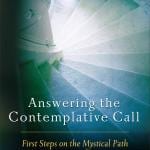
A reader of this blog wrote to ask me this question:
How does Centering Prayer differ from Christian Meditation as taught by John Main?
In Centering Prayer you allow the prayer word to “fall away” on it’s own.
And though, in Christian Meditation, you are meant to keep repeating the Prayer Word (Maranatha) throughout the period of prayer, it too falls away and you are in the silence until one’s “inner commentator” kicks in.
So how are they really different?
And is “letting go” of the prayer word in Centering Prayer the same as falling asleep in that it just happens without you realising it?
I’ve always been stumped by what to do with the prayer word in Centering Prayer when you no longer need it.
Thanks for a great question.
Christian Meditation and Centering Prayer refers to two different methods of silent prayer — the first taught by John Mail, Laurence Freeman, and the World Community for Christian Meditation; while Centering Prayer comes from the teachings of William Meninger, Thomas Keating and Basil Pennington, and the ministry of Contemplative Outreach.
To answer your question: “are they really different?” let’s look at the instructions for Christian Meditation and Centering Prayer, as found on the WCCM and CO websites.
First, Christian Meditation:
Sit down. Sit still with your back straight. Close your eyes lightly. Then interiorly, silently begin to recite a single word – a prayer word or mantra. We recommend the ancient Christian prayer-word “Maranatha.” Say it as four equal syllables. Breathe normally and give your full attention to the word as you say it, silently, gently, faithfully and – above all – simply.
The essence of meditation is simplicity. Stay with the same word during the whole meditation and in each meditation day to day. Don’t visualise but listen to the word, as you say it. Let go of all thoughts (even good thoughts), images and other words. Don’t fight your distractions: let them go by saying your word faithfully, gently and attentively and returning to it as soon as you realise you have stopped saying or it or when your attention wanders.
Meditate twice a day, morning and evening, for between 20 and 30 minutes. It may take a time to develop this discipline and the support of a tradition and community is always helpful.[1]
Now, the instructions for Centering Prayer:
1. Choose a sacred word as a symbol of your intention to consent to God’s presence and action within.
2. Sitting comfortably, (but not too comfortably which may induce sleep) your back straight and with your eyes closed, settle briefly and then silently introduce the sacred word as a symbol of your intention to consent to God’s presence and action within.
3. When you engage with thoughts, return ever so gently to the sacred word.
4. At the end of the prayer period, remain in silence for a few minutes with your eyes closed.[2]
Understanding these Different Ways to Pray
So is there a difference? Yes, but it is subtle. Christian Meditation instructs the practitioner to return to the “prayer word” as soon as you realise you have stopped saying or it or when your attention wanders. By contrast, Centering Prayer only calls for returning to the “sacred word” when you engage with thoughts. So, simply noticing that you have “stopped saying it” does not necessarily mean you need to be repeating it.
Notice that each method describes the word differently. Centering Prayer calls for a sacred word while Christian meditation calls for a prayer word. Maybe this is just splitting hairs, but let’s be meticulous with the terminology. Because the sacred word really is something different from the prayer word.
Every Centering Prayer teacher I’ve ever talked to makes the point that the sacred word in Centering Prayer is not a mantra. In other words, the purpose behind the sacred word is not to repeat it mechanically for the duration of the prayer time. It is simply a prayerful way to “distract” the wandering mind from, well, wandering.
In practice, of course, most of us have such unruly, undisciplined minds — the “monkey mind” of Buddhist lore, or what Martin Laird calls “the cocktail party” — that we probably will, in fact, return to the sacred word again and again and again. At least for many prayer “sessions” as we slowly learn to relax into the undistracted silence that is always waiting for us between and beneath all our thoughts.
“The goal in Centering Prayer is not to stop thoughts altogether, but to develop a detached attitude toward them. Fighting your thoughts is useless; releasing them is blessed.” — Cynthia Bourgeault, The Heart of Centering Prayer
Think of your awareness during Centering Prayer as consisting of a three-legged stool. One leg of the stool is your sacred word or verse: the “content” you have chosen to entrain your awareness on. But of course, the monkey-mind is unruly and so you will continually have distracting thoughts, feelings, and sensations. Distractions, therefore, are the second leg of the stool. Most of our experience during Centering Prayer will be a kind of ping-pong between the sacred word, the distractions; back to the sacred word, then along comes more distractions, and so forth and so on.
What’s the third leg of the stool then? Simply this: silence.
The silence is always there. It’s there between and beneath all our distracting thoughts and feelings and sensations. It’s also there in the middle of the sacred word. And sometimes, by the grace of God, both sacred word and distractions fall away, and our attentions comes to rest, gently and gratuitously, on nothing other than the silence.
And then what happens? Usually another distracting thought pops up, sometimes as a commentary on the silence itself (“Wow, isn’t this great? I’m finally getting the hang of Centering Prayer!“) but just as often, it’s just some random thought, about last night’s dinner or the fight you had with your brother in 1988.
And then you notice you’re distracted, so you return to the sacred word. And the cycle continues.
By contrast, Christian Meditation’s use of a prayer word is more consistent with the traditional eastern practice of a mantra — you are instructed to keep reciting the prayer word, even when you notice that it has fallen away and you are simply resting in the silence.
So the two methods are subtly different, but they are indeed different.
I should post a disclaimer here: I have not been formally instructed in the John Main method of Christian Meditation, so it’s possible I am misunderstanding the instructions. If a WCCM teacher is reading this and cares to correct me, please leave a comment or contact me directly.
The Un-Experienced Experience
Now, on to my reader’s second question:
And is “letting go” of the prayer word in Centering Prayer the same as falling asleep in that it just happens without you realising it?
I’ve always been stumped by what to do with the prayer word in Centering Prayer when you no longer need it.
Sometimes one may fall asleep during centering prayer, but hopefully if one is getting enough sleep, that doesn’t happen very often! But I think the analogy is not that bad. Yes, the sacred word dropping away “just happens without you realizing it” — but ideally while remaining awake.
In other words, the dropping-away of the sacred word and the resultant “objectless awareness” (as Cynthia Bourgeault describes it) is not someone we can make happen. Indeed, to try to make it happen is to fall back into the monkey-infested cocktail party.
It is a graced moment. It is marked by deep humility, which means self-forgetfulness. Which means, often this happens and we are likely to “miss it” as our mind focusses on whatever the next distracting thought is that comes along.
The great contemplative teacher Gerald May, who died in 2005, wrote about this in his classic book Will and Spirit: A Contemplative Psychology. He uses the term “unitive experience” to describe “the self-losing experience that is the fundamental, paradigmatic experience of consciousness, mystery, and being. It constitutes true intuition and radical spontaneity. It is the keystone of contemplative spirituality.” He then makes this fascinating statement:
It is my impression that extremely brief unitive experiences happen to most people numerous times each day, but are so very short-lived that they go unnoticed. There is, I am certain, the potential for unitive experience at each blinking of the eyes, at each pause in the breath.21 But such experiences are seldom recognized. The ones that are noticed are those that last longer, and these are the ones that are capable of leaving indelible marks upon people’s lives.
In other words, many times when our awareness falls into nonduality, we simply don’t notice it — because our minds become fixated on whatever thought happens next!
May suggests that this happens to all people, literally all the time. So why bother with a contemplative practice like Centering Prayer? Because it is a way of exercising our awareness so that we are more likely to pay attention when nondual awareness arises, both during prayer and at other times during the day.
But for most of us, most of the time, we will continue to ignore, miss, or even repress moments of encountering the Divine presence in our lives, both during prayer and at other times. This is why so many people experience Centering Prayer (or other contemplative practices) as so frustrating — we pay attention to all the distracting moments, and we let the unitive moments slide by, beneath our conscious awareness.
So this is why I think it’s so important for practitioners of Centering Prayer — or other contemplative practices — to be non-judgmental about the “quality” of our prayer time. We need to gently remind ourselves that our minds are more at home with dualistic awareness, so we naturally pay more and better attention to all the moments that we are lost in distracted thoughts. But the graced, unitive moments continue to happen, and the more we persevere in this kind of disciplined prayer, the more stable our minds and hearts become, and the more likely we are to actually catch those moments of grace — even if just fleetingly.
I hope this is helpful. It’s a great question, and sometime many of us struggle with. What to “do” with the sacred word, when you no longer need it? Just let it go. And then when you catch yourself thinking some random thought, pick it up again. The key words in the instruction are “ever so gently.” Be gentle with this process — and with yourself. Remember, the heart of Centering Prayer is the love of God. You don’t have to do anything — anything at all — to make God love you. You simply simply and rest in the Divine presence.
[1]Source: www.wccm.org/content/how-meditate accessed 2/28/19
[2]Source: www.contemplativeoutreachireland.com/centering-prayer/the-method-of-centering-prayer/ accessed 2/28/19
Enjoy reading this blog?
Click here to become a patron.














